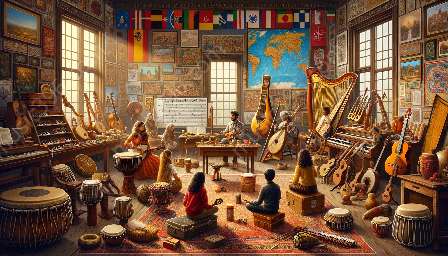Music has been an integral part of human civilization, and the historical roots of specific instruments in different cultures provide an enriching tapestry of diversity and innovation. This topic cluster seeks to delve into the origins and evolution of musical instruments across various cultural landscapes, examining their significance in the realms of instrument studies and music education.
Introduction to Instrument Studies
Instrument studies encompass a wide array of disciplines, including ethnomusicology, musicology, and organology, that focus on the exploration of musical instruments. Understanding the historical roots of specific instruments in different cultures is crucial to comprehending the diverse musical traditions and the impact of these instruments on the societies that nurtured them.
String Instruments: The Ancient Roots of the Oud
The oud, a pear-shaped string instrument widely used in Middle Eastern, North African, and Eastern European music, traces its historical roots to ancient Mesopotamia. As one of the oldest known instruments of its kind, the oud has evolved over millennia, being embraced by diverse cultures and retaining its prominence in contemporary music. Its significance in instrument studies lies in its role as a bridge between historical traditions and modern musical expressions.
Wind Instruments: The Origins of the Siku in Andean Culture
In the Andean culture of South America, the siku holds profound historical significance. Also known as the Andean Panpipe, the siku has roots dating back to pre-Columbian times, symbolizing the spiritual and cultural heritage of the indigenous peoples. Exploring the historical roots of the siku sheds light on the enduring traditions of Andean music and the enduring legacy of ancient wind instruments, making it a compelling study in the context of music education and instrument studies.
Percussion Instruments: The Cultural Nexus of the Tabla
The tabla, a pair of hand drums central to North Indian classical music, has historical roots connecting to the Indian subcontinent's rich and diverse cultural tapestry. The intricate rhythms and emotive qualities of the tabla have made it an indispensable component of Indian music, and its historical evolution reflects dynamic cultural interactions. Understanding the historical roots of the tabla contributes to a comprehensive understanding of the intricate interplay between music, culture, and tradition, serving as a significant topic of interest in instrument studies.
Musical Education and Cultural Understanding
The exploration of historical roots of specific instruments in different cultures serves as a gateway to promoting cultural understanding and appreciation. Incorporating this knowledge into music education enriches the learning experience by offering a global perspective on musical traditions and fostering a sense of unity amidst diversity.
Conclusion
Delving into the historical roots of specific instruments in different cultures reveals the fascinating interplay of history, culture, and music. Embracing this diversity through instrument studies and music education cultivates a more profound understanding of the world's musical heritage, nurturing a sense of interconnectedness and appreciation for the ingenuity and creativity embedded in the historical roots of specific instruments in different cultures.















